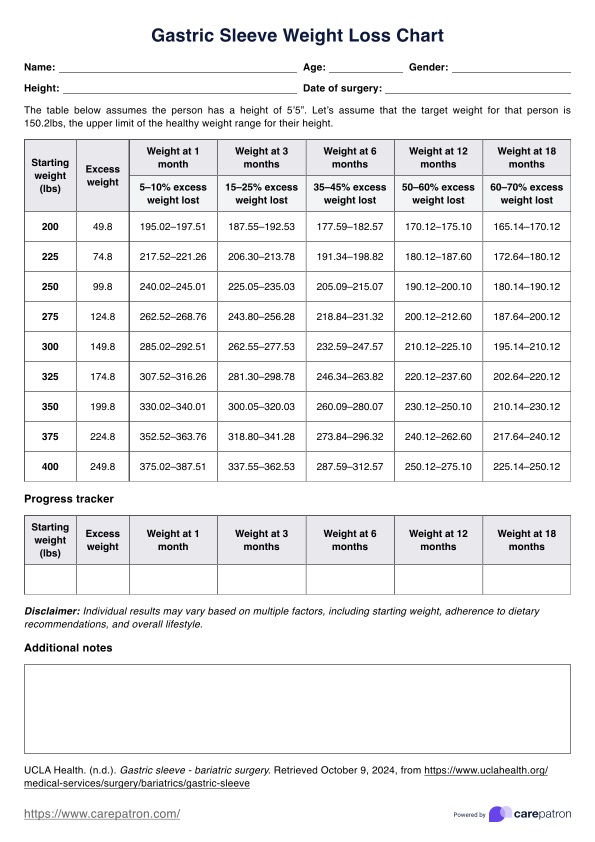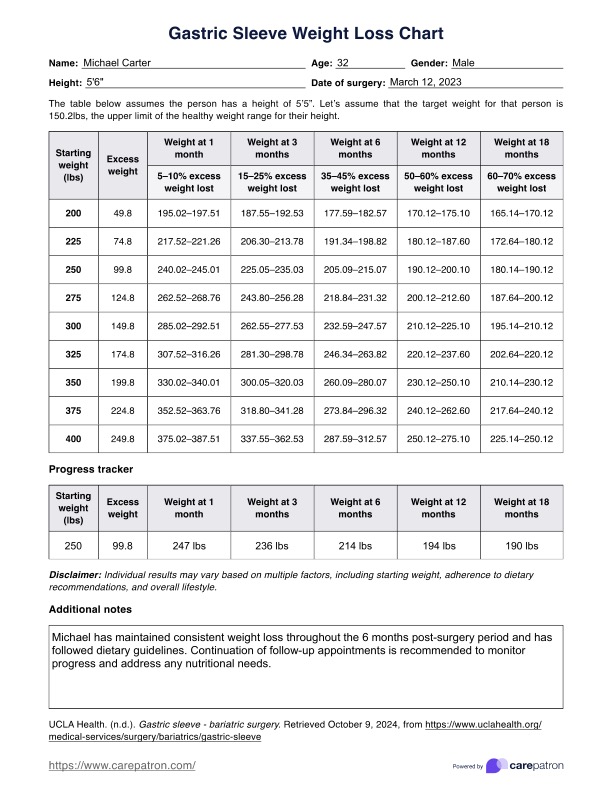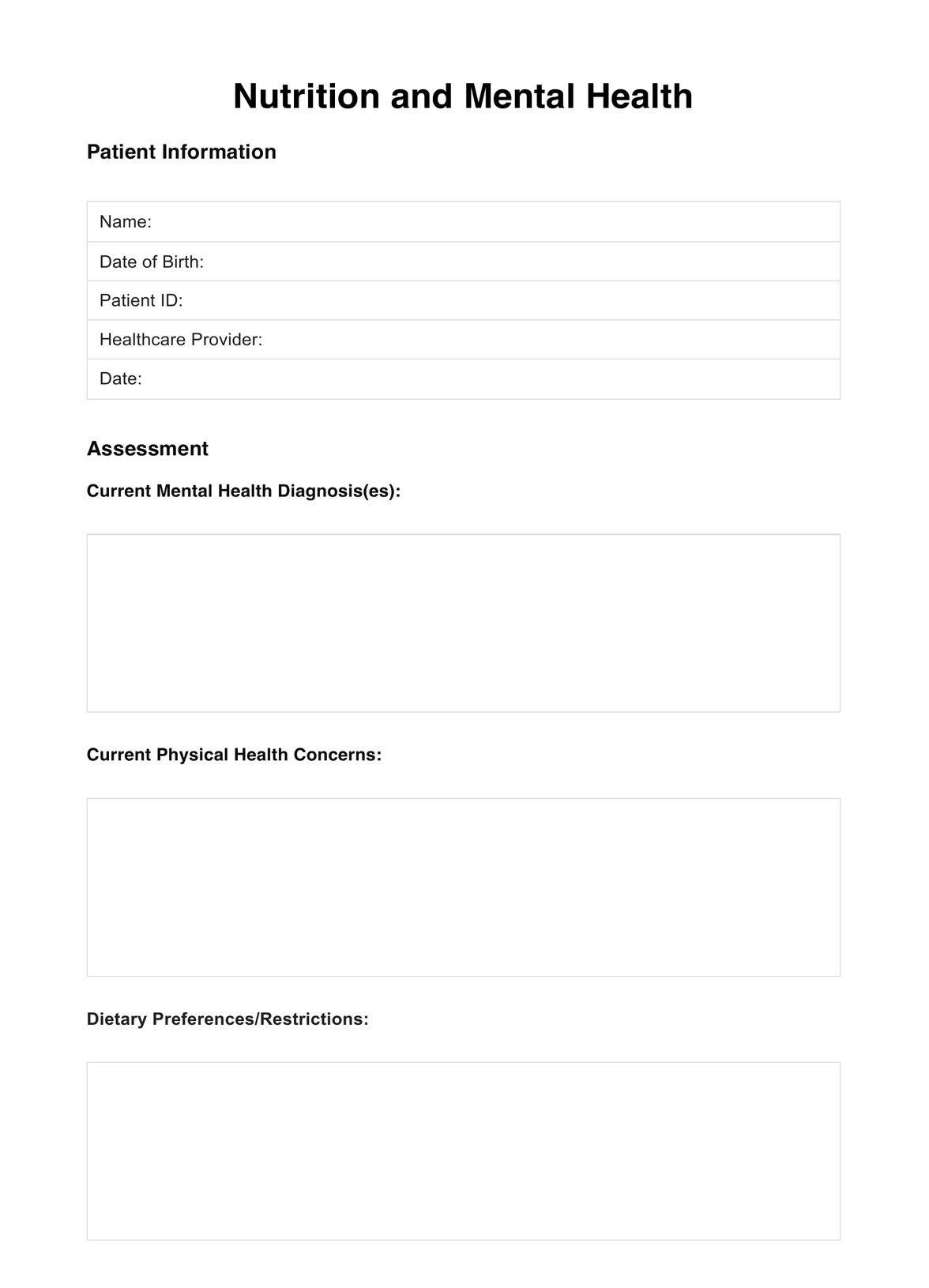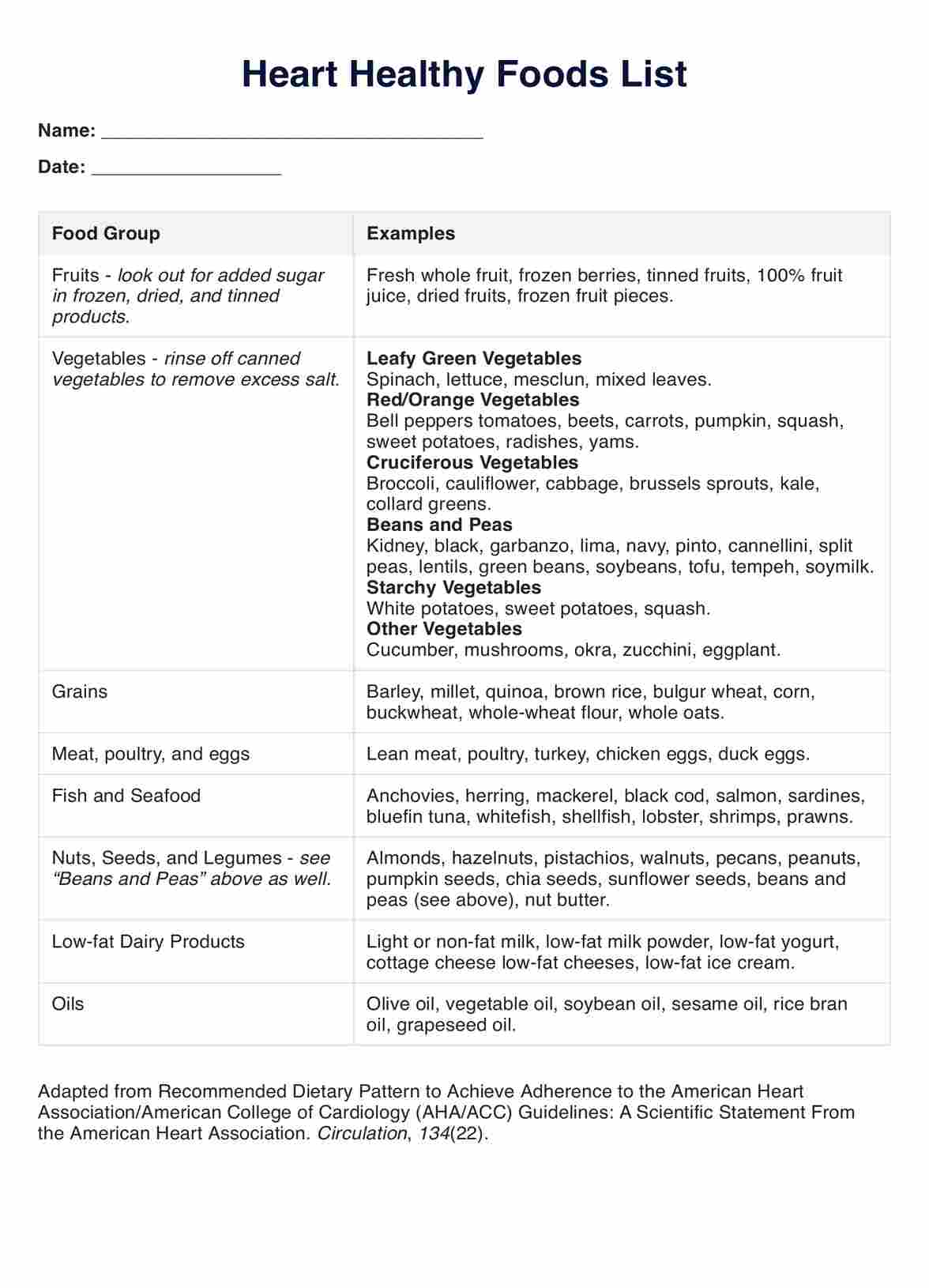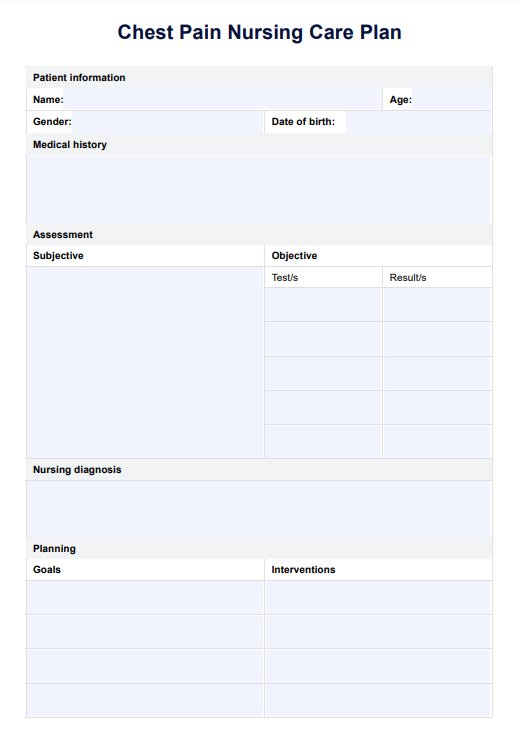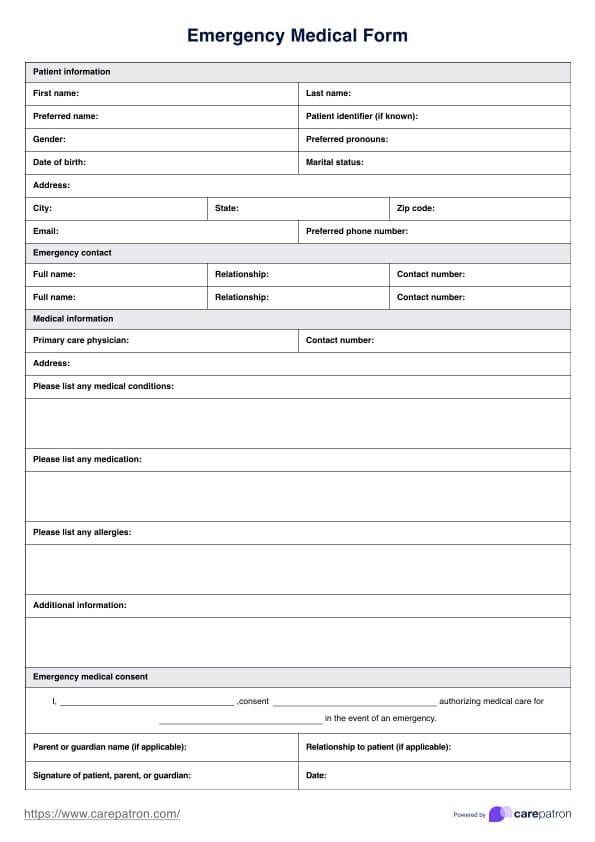Gastric Sleeve Weight Loss Chart
Use our Gastric Sleeve Weight Loss Chart template to effectively manage patient expectations and track progress before or after the gastric sleeve procedure.


What is a Gastric Sleeve Weight Loss Chart template?
Bariatric surgery, such as gastric sleeve surgery (vertical sleeve gastrectomy or VSG), is a widely used solution for those aiming for significant weight loss. Gastric sleeve surgery reduces the stomach to a sleeve-like structure, helping patients manage their food intake and achieve long-term weight reduction.
Our Gastric Sleeve Weight Loss Chart is a tool for effectively tracking weight loss post-surgery. The chart predicts expected weight loss over time. It also has fields for entering the actual weight loss of a patient, allowing healthcare professionals and patients to monitor progress regularly. This ensures that both parties can assess the effectiveness of the surgery and make necessary adjustments to the patient's recovery plan.
Gastric Sleeve Weight Loss Chart Template
Gastric Sleeve Weight Loss Chart Example
How to use our Gastric Sleeve Weight Loss Chart template
Our Gastric Sleeve Weight Loss Chart template is designed to be easy to use, ensuring both healthcare professionals and patients can track progress efficiently. Below are the steps to guide you through the process.
Step 1: Download the template
Access the Gastric Sleeve Weight Loss Chart template by clicking "Use template." The template is designed for ease of use and customizability and includes sections to help monitor patient progress. You may also download a non-customizable but still fillable PDF version by clicking "Download."
Step 2: Enter patient details
After accessing the template, input the patient's essential information, such as their name, starting weight, surgery date, and initial BMI.
Step 3: Track progress
Use the template to document the patient’s full and excess body weights at regular intervals, including 1 month, 3 months, 6 months, 12 months, and 18 months post-surgery. Once you have recorded the patient's actual weight loss, compare them with the table's values. Take note that the table contains expected weight loss values; the actual weight loss of each patient will vary.
Step 4: Secure and store
Once the data is recorded, ensure the template is stored securely in compliance with patient confidentiality regulations. Only authorized personnel should access this information, ensuring patient privacy and data protection.
When to use the Gastric Sleeve Weight Loss Chart template
The Gastric Sleeve Weight Loss Chart template is helpful in various stages of the weight loss journey. It supports healthcare providers in delivering clear expectations, including how much weight patients can anticipate losing and tracking success at multiple points.
Pre-gastric sleeve surgery planning
The weight loss chart is a visual tool for setting patient expectations for bariatric surgery before surgery. It helps healthcare professionals explain the whole weight loss surgery process and potential outcomes, giving patients a realistic understanding of what to expect in the months following surgery.
Post-surgery tracking
Once the surgery is complete, the chart becomes essential for monitoring the patient’s progress. Adhering to a clear liquid diet is crucial during the initial post-operative phase to facilitate recovery, aid in weight loss, and prevent complications. It provides a month-by-month breakdown of expected weight loss, allowing healthcare professionals to identify whether the patient is on track or if any interventions are required to further the weight loss timeline to ensure long-term success.
Motivational support
Beyond tracking, the weight loss chart is a motivational tool for patients. Healthy eating habits are crucial for long-term success, as they ensure recovery, maintain weight loss, and avoid complications. Seeing their weight decrease over time encourages them to adhere to their dietary plans and exercise routines, fostering the behavioral changes necessary for sustainable weight loss.
Results and interpretation
The Gastric Sleeve Weight Loss Chart outlines expected weight loss for gastric sleeve patients post-surgery. While ideal weight loss varies from patient to patient, the chart helps set benchmarks and manage expectations.
- 1 month: Patients typically lose 5-10% of their excess weight within the first month. For instance, a patient starting at 300 lbs may see a reduction to around 283 lbs.
- 3 months: Patients may have lost 15-25% of their excess weight by the third month. In this case, a 300-lb patient might weigh approximately 250 lbs.
- 6 months: At six months, weight loss reaches 35-45%. Patients who began at 300 lbs may now weigh around 210 lbs, showing steady progress.
- 12 months: Around one year post-surgery, patients may experience a 50-60% excess weight loss. For a starting weight of 300 lbs, this could translate to a weight of about 185 lbs.
- 18 months: By this point, most patients stabilize their weight, losing around 60-70% of their excess weight. A patient who started at 300 lbs may now weigh around 175 lbs.
These results provide an approximate range of expected outcomes, but it’s important to note that individual progress varies based on several factors.
Benefits of using our template
Our Gastric Sleeve Weight Loss Chart offers various advantages to healthcare professionals with bariatric patients. Here’s how this tool can enhance your practice.
Clear tracking of patient progress
The template offers a simple, straightforward way to monitor patient weight loss over time. This structured chart allows healthcare providers to ensure they capture accurate data and track patient progress efficiently.
Improved patient adherence
Having a visual representation of their weight loss helps patients stay committed to their post-surgery plans. Introducing solid foods gradually is crucial for dietary adherence, as it ensures a smooth transition and prevents complications. The chart motivates patients to follow dietary and exercise recommendations by showing them the milestones they need to reach to regain weight.
Better patient-provider communication
The template facilitates open discussions between healthcare providers and patients, helping to set realistic expectations and adjust plans if needed. Sharing the chart allows both parties to align on goals and address concerns throughout the weight loss journey.
Commonly asked questions
Patients typically begin losing weight immediately after surgery, with noticeable results within the first month. Most patients lose 5-10% of their excess weight during this initial period.
Several factors can impact weight loss results, including a patient's starting BMI, adherence to dietary recommendations, physical activity levels, and overall health. Age and pre-existing health conditions may also play a role.
Maximum weight loss is typically achieved between 12 and 18 months after surgery. Patients usually lose 60-70% of their excess weight by this time, but results may vary.


